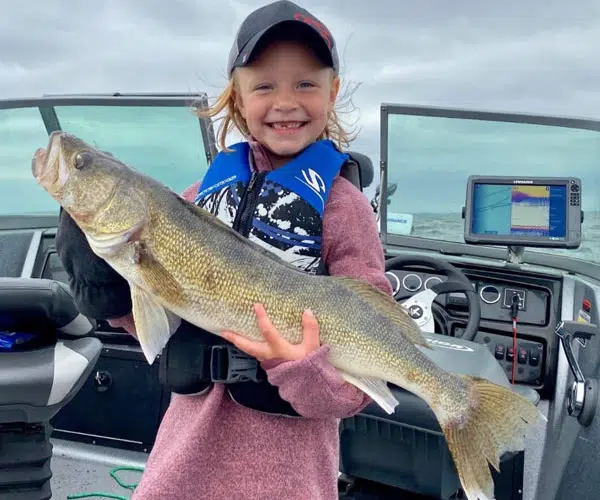
Fishing is picking up a bit now that water temperatures are beginning to drop. For walleye, try a live bait rig as close to the bottom as possible, especially at first and last light. Bass remain eager to bite. Again, low light hours have been best.
While dropping, water temperatures remain near peak summer highs so fish are still very vulnerable. Please bring along the right equipment to quickly unhook fish so they can be returned to the water as soon as possible.
Anglers are asked to fish bodies of water close to home, and practice social distancing at the boat landings and shorelines.
For rules, regulations and other helpful information on fishing in Minnesota, consult the DNR’s Fish Minnesota web page.
[Northeast] [Northwest] [Central] [Minneapolis-St. Paul Area] [Southern]
Northeast Minnesota
Ely
Walleye fishing remains challenging for some, but good to excellent for others. The key has been to fish during the first two hours and last two hours of the day when the walleye have been the most willing to bite. Dragging jigs tipped with half a crawler along the bottom has been very effective. Trolling shad raps, and dragging lindy rigs tipped with crawlers or minnows have also worked well for many anglers. Look for walleye around the sunken islands and transition areas in 12-18 feet of water.
Smallmouth bass continue to be caught on topwater lures early and late in the day. Whopper ploppers have been hard to beat, but poppers and hula poppers account for their fair share of bass. Anglers are also finding smallies when using jigs tipped with twisters or half a crawler out around the sunken islands. Largemouth bass continue to be found in the shallow lily pads and wild rice beds when using topwater frogs dragged on the surface early and late in the day. Once the sun rises, switch to spinner baits and soft plastics at the weedlines.
Anglers have been catching rainbow trout high in the water column, 3-5 feet below the surface, late in the day on area stream trout lakes. Calm evenings have been key to this shallow water bite. As the sun goes down, water temperatures drop and the rainbows rise to feed on the surface. Anglers have been catching rainbows by trolling small crank baits, flatfish and small spoons high in the water column.
Northern pike anglers continue to find active pike throughout the day. Spoons, spinnerbaits and large minnow baits fished in and around the weed beds have been very effective. Some pike are also being found out around the sunken islands.
Crappies continue to be found scattered out over the deep lake basins. Anglers have been locating crappies when using electronics. Once found, jigs and minnows have been very effective, but jigs and twisters or hair jigs have also produced fish. During the evening hours, most of the crappies are coming from the weed beds and weedlines. 800-777-7281; www.ely.org
Duluth – Lake Superior, St. Louis River and inland waters
Anglers continue to have success, despite inconsistent weather patterns. The bite has been best on calm days and prior to a storm. Some waters are running high due to frequent rainfall and storms, making lakeshores susceptible to damage from boat wakes – please keep this in mind when running your boat near shore. Rivers and streams are also high but all area waters should return to normal in a few days. Water temperatures remain on the higher side, running 72- to 78-degrees depending on where you are fishing.
Lake Superior is giving up some nice fish. On the North Shore, Jim’s flashbacks have been popular, especially in pinks, limes and bright oranges. Pink lemonade seems to offer more frequent bites. Lots of boats have moved into close proximity to Duluth, concentrating on “beach trout.” Depths of 30-70 feet have been best, but location and depths can change overnight. While lake trout are dominating the catch, occasional salmon are also being taken. The South Shore continues to produce a few walleye. The best approach has been to troll deep-diving crank baits in and around 30 feet of water. Please remember to practice catch-and-release (especially with the larger fish) when working a vulnerable school of feeding fish. Stream fishing has slowed due to high and fast waters.
August is usually a tough month on the St. Louis River, but fishing improves nicely during the month of September. Currently, some anglers are doing well with the smallmouth bass in the upper sections of the river. Ripping rattling traps or soft plastic boot tails is turning good-size fish. Catfish action remains strong for those using live bait presentations. Like the streams, the river has a strong current and it is muddy.
The inland waters continue to give up multiple species on live bait rigs. The best bet is to slowly troll composite blade harnesses tipped with a night crawler, or to speed troll crank baits along the contour lines. Anglers will want to concentrate their efforts over 20 feet of water near the shoreline or mid-lake humps, especially during low light periods. Panfish remain in the cover of docks, rocks and vegetation. A simple small hook, leech and split shot under a float is a good tactic. Largemouth bass are also in the cover, but prefer spinner salad cutter baits and topwater-type lures. 800-438-5884; www.visitduluth.com
Grand Rapids
Fishing has been pretty good this week. Walleye, northern pike, muskie, panfish and bass have all been actively biting now that water temperatures have cooled a bit. Bass and panfish can both be found at the deeper cabbage and coontail edges. For steady panfish action, use panfish leeches, nightcrawlers or wax worms on a small 1/32-ounce jig. Often, just a larger presentation will entice the bass to bite. A skirted jig and crawdad combination is providing a lot of action, especially when worked in 12-16 feet of water. Walleye anglers are having the best success trolling spinner rigs and nightcrawlers in 18-25 feet of water at 1-1.7 mph. Covering water to find actively feeding fish has been the key to better-than-average days. Deep weed edges, rocky humps and points, and windblown areas should all be checked for fish. Muskie and northern pike have also been cooperating. Most of the fish have been caught at the deeper weed edges and primary structure protruding into the main lake. Key depths for active fish are 8-16 feet of water, with fish responding best to buck tails, jerk baits and large rubber baits. www.visitgrandrapids.com
Northwest Minnesota
Baudette – Lake of the Woods & the Rainy River
Lots of eating-size, slot-size and trophy-size walleye are being reported on the south end of Lake of the Woods. Many walleye are hanging out on the deep mud in 30-36 feet of water so covering water by drifting or trolling crawler harnesses (snelled spinners) in hammered gold, pink, glow or orange with a 1- to 2-ounce weight has been a great approach. Another good technique is to troll crank baits through schools of walleye over the deep mud, but anglers need to get their baits down to the fish using lead core line, a 4-ounce bottom bouncer, snap weights, a 3-way rig or downriggers. Productive colors include pink UV, firetiger, chrome-blue, and gold.
On the Rainy River, walleye can be found scattered on the flats and in the deeper holes. Trolling crank baits will be the most effective for a mix of walleye and sauger. Sturgeon anglers are doing well when targeting the deep holes using sturgeon rigs with crawlers or frozen emerald shiners. Smallmouth bass and northern pike are active around the current breaks, rocky areas and weed edges. The Rainy River is a world class fishery, but things used to be different. Learn more about this incredible success story!
Up at the Northwest Angle, anglers report a strong walleye bite on the mud adjacent to reefs and islands. Similar to the south end of the lake, spinners and crawlers or trolled crank baits are producing good numbers of fish. Northern pike and muskie are being caught by anglers casting the bays and trolling the rocky point areas. For smallmouth bass, hit depths of 4-15 feet in the rocky areas.
Until the U.S./Canada border opens, guests can travel across the lake and stay in Minnesota waters. Learn more at Boating to the Northwest Angle. 800-382-FISH; www.lakeofthewoodsmn.com
Bemidji
This past weekend brought lots of thunderstorms and heavy rain which affected the bite a bit. Anglers that were patient boated a few walleye on Lakes Bemidji, Andrusia, Turtle and Plantagenet. Live bait rigs with leeches, crawlers or larger creek chubs turned the most fish, but spinners and crawlers worked along the outside weed edges also worked. Bass fishing was and remains excellent for those using plastics or topwater baits. Crappies and bluegills are scattered along the cabbage weeds. Muskie have started hitting bucktails on Lakes Bemidji and Plantagenet. Please practice selective harvesting to ensure the health of the fisheries for years to come. 800-458-2223; www.visitbemidji.com
Walker – Leech Lake
The walleye are in their summer mid-lake patterns on Leech Lake. One guide had lots of success this week when pulling rapalas through 9-11 feet of water on the mid-lake flats during the day. He also found fish in depths of 12-14 feet adjacent to the 9-11 foot areas. During evening hours, Walker Bay was a good place to start, with walleye coming in on bottom bouncers and leeches. Chartreuse has been the top producing color. Other anglers did well when bobber fishing in Walker Bay. 800-833-1118; www.leech-lake.com
Central Region
Otter Tail Area Lakes
Fishing has been very good during the month of August. Bottom bouncing has been working well since it is a great way to cover water and locate schools of fish after a few passes. Once a school has been found, mark the depth of the fish because it will stay fairly consistent for the remainder of the day. Baitfish are on the move but if you find a group of baitfish, you should find walleye nearby. Spinning blades are working well on the bottom bouncers, but jigging raps and puppet minnows are also producing fish on the deeper humps. Be sure to check the nearby edges as well. Water temperatures will begin to drop very soon, and fishing will continually improve and become more consistent. The fall bite is getting close! 800-423-4571; www.ottertailcountry.com
Isle/Onamia – Lake Mille Lacs
Walleye fishing on Lake Mille Lacs was a bit more difficult last weekend, likely due to abundant bait fish and bugs. Anglers took some walleye when trolling in less than 18 feet of water. Some walleye came in on a leech under a bobber out on the bars. Others were found when lindy rigging leeches or crawlers up on the rock points.
The smallmouth bass have moved deeper. For lots of bass action, use an aggressive approach with a ned rig, drop shot or tube jig. Few anglers are reporting muskie action, however, there’s a great tullibee population so the bite should be strong by this fall.
Please remember that when water is this warm, anglers must handle fish carefully. Try to hook the fish quickly, then bring them up slowly. The less handling, the better. Check out current lake conditions at the Mille Lacs Lake Webcams web page. 888-350-2692; www.millelacs.com




Comments